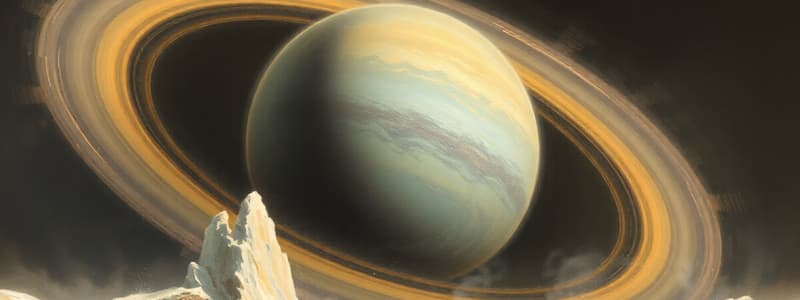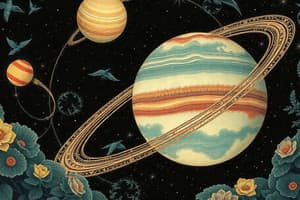Podcast
Questions and Answers
What primary characteristic distinguishes Uranus from gas giants?
What primary characteristic distinguishes Uranus from gas giants?
- Its primary composition is of flowing icy materials. (correct)
- It has a significantly weaker magnetic field.
- It lacks a solid core.
- It does not have any rings.
Why does Uranus appear blue-green in color?
Why does Uranus appear blue-green in color?
- High concentration of helium in its atmosphere.
- Absorption of red light by its icy core.
- Dust storms reflecting sunlight.
- Presence of large amounts of methane. (correct)
What is unique about Uranus's rotation compared to most other planets in the solar system?
What is unique about Uranus's rotation compared to most other planets in the solar system?
- It rotates in the same direction as Venus.
- It completes a rotation in 84 Earth years.
- It rotates nearly perpendicular to its orbital plane. (correct)
- It does not rotate at all.
Why would a metal spacecraft be unable to explore Uranus's atmosphere?
Why would a metal spacecraft be unable to explore Uranus's atmosphere?
What is the likely composition of the inner moons of Uranus?
What is the likely composition of the inner moons of Uranus?
Which spacecraft was the first to fly past Uranus?
Which spacecraft was the first to fly past Uranus?
How Was Uranus Initially Discovered?
How Was Uranus Initially Discovered?
What is the approximate orbital period of Uranus (time to revolve around the sun)?
What is the approximate orbital period of Uranus (time to revolve around the sun)?
What did Voyager 2 discover about Uranus during its flyby?
What did Voyager 2 discover about Uranus during its flyby?
What is the primary mission objective when the New Horizons spacecraft is awakened during its eight-year interplanetary journey?
What is the primary mission objective when the New Horizons spacecraft is awakened during its eight-year interplanetary journey?
Which of the following is a major moon of Uranus?
Which of the following is a major moon of Uranus?
What is the likely origin of the moons orbiting outside of Oberon?
What is the likely origin of the moons orbiting outside of Oberon?
How does the tilt of Uranus affect its seasons, compared to Earth?
How does the tilt of Uranus affect its seasons, compared to Earth?
Beyond direct observation by spacecraft, how is the remaining information about Uranus gathered?
Beyond direct observation by spacecraft, how is the remaining information about Uranus gathered?
Why did the New Horizons spacecraft not capture images of Uranus during its journey to Pluto?
Why did the New Horizons spacecraft not capture images of Uranus during its journey to Pluto?
How does Uranus's composition compare to that of Saturn?
How does Uranus's composition compare to that of Saturn?
If a new spacecraft were sent to Uranus, what challenges would it face in exploring the planet's atmosphere?
If a new spacecraft were sent to Uranus, what challenges would it face in exploring the planet's atmosphere?
How does the appearance of Uranus's rings differ?
How does the appearance of Uranus's rings differ?
Uranus was named after the Greek god of the sky. Which planet was named after Uranus's father?
Uranus was named after the Greek god of the sky. Which planet was named after Uranus's father?
Which of the following statements best describes Uranus's magnetic field compared to Saturn's?
Which of the following statements best describes Uranus's magnetic field compared to Saturn's?
Flashcards
What is Uranus?
What is Uranus?
First planet discovered using a telescope, very cold and windy.
Who is Uranus (Mythology)?
Who is Uranus (Mythology)?
Greek god of the sky and father of Kronos (Saturn).
What are Uranus' Rings?
What are Uranus' Rings?
A set of 13 faint rings surrounding Uranus; inner rings are narrow and dark, outer rings are brightly colored.
Uranus's Axial Tilt
Uranus's Axial Tilt
Signup and view all the flashcards
Uranus's Color
Uranus's Color
Signup and view all the flashcards
Uranus's Atmosphere Composition
Uranus's Atmosphere Composition
Signup and view all the flashcards
Uranus's Rotation
Uranus's Rotation
Signup and view all the flashcards
Uranus's Rotation Period
Uranus's Rotation Period
Signup and view all the flashcards
Uranus's Orbital Period
Uranus's Orbital Period
Signup and view all the flashcards
Uranus's Surface
Uranus's Surface
Signup and view all the flashcards
Major Moons of Uranus
Major Moons of Uranus
Signup and view all the flashcards
Composition of Uranus' Inner Moons
Composition of Uranus' Inner Moons
Signup and view all the flashcards
Spacecraft to Visit Uranus
Spacecraft to Visit Uranus
Signup and view all the flashcards
Observations of Uranus
Observations of Uranus
Signup and view all the flashcards
Study Notes
- Uranus was the first planet discovered using a telescope.
- It is an ice giant, not a gas giant, comprised mostly of flowing ices over a solid core.
- Uranus is very cold and windy.
- Named after the Greek god of the sky, who was the father of Kronos (Saturn).
Rings
- It has 13 faint rings.
- The inner rings are narrow and dark.
- The outer rings are brightly colored and more visible.
Rotation and Orbit
- Uranus rotates at a nearly 90-degree angle from its orbital plane.
- It appears to spin on its side due to this tilt.
- Uranus rotates in the opposite direction of most planets, similar to Venus.
- Unlike any other planet, it rotates on its side.
- One rotation lasts 17 hours.
- One revolution around the sun takes 84 Earth years.
Atmosphere
- Uranus appears blue-green because of large amounts of methane.
- It has a thick atmosphere made of methane, hydrogen, and helium.
- Uranus lacks a true surface and is mostly swirling fluids.
- Extremely high pressures and temperatures would destroy a metal spacecraft.
Moons
- Uranus has 28 known moons.
- Five major moons: Miranda, Ariel, Umbriel, Titania, and Oberon.
- Inner moons (observed by Voyager 2) are roughly half water ice and half rock.
- Moons outside Oberon's orbit are likely captured asteroids.
Exploration
- Voyager 2 is the only spacecraft to have visited Uranus.
- Voyager 2 flew past Uranus after traveling 3 billion kilometers in nine years.
- Voyager 2 gathered information about the planet's rings and moons in only six hours.
- Voyager 2 discovered 10 new moons, two new rings, and a magnetic field stronger than Saturn's.
- Observations from the Hubble Space Telescope and powerful ground-based telescopes have also provided information about Uranus.
- In March 2011, the New Horizons spacecraft crossed Uranus' orbit on its way to Pluto.
- New Horizons did not take any images of Uranus.
- The spacecraft remains mostly inactive during its eight-year journey from Jupiter to Pluto, waking up for 50 days each year for instrument checkups.
Studying That Suits You
Use AI to generate personalized quizzes and flashcards to suit your learning preferences.




